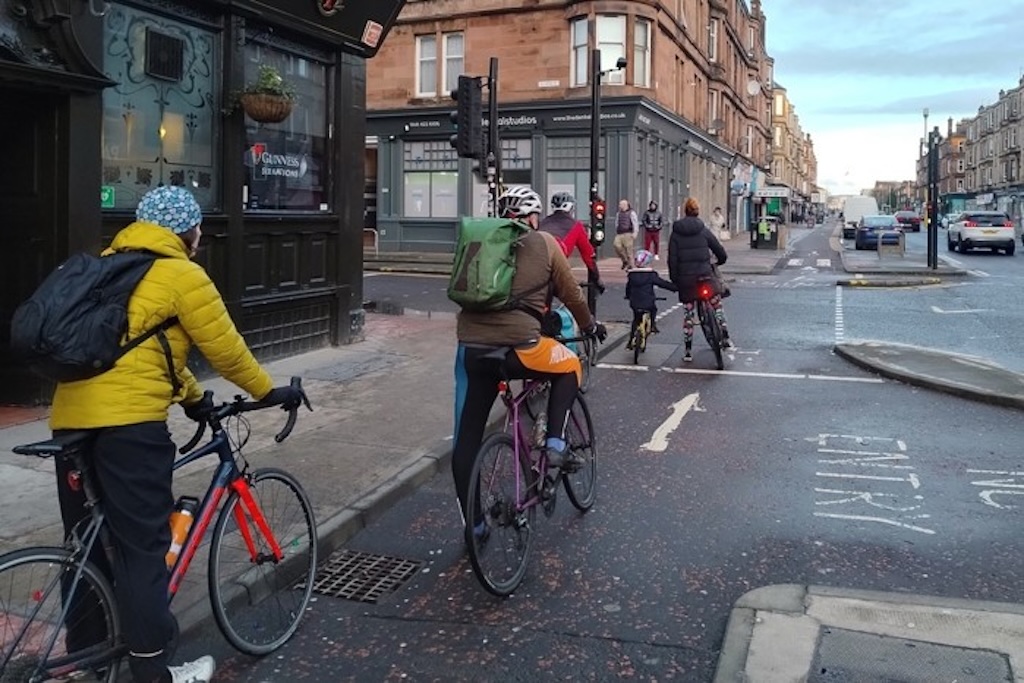It’s not Amsterdam or Copenhagen leading the latest cycling revolution—it’s Glasgow, Scotland. In May 2025, Scotland’s largest city reached a milestone that would make any transportation planner in Portland, or Montreal do a double take: during the morning rush hour, there were more bicycles than cars traveling along Victoria Road, a major artery on the city’s South City Way cycle route.
The numbers tell a fantastic story. A daily average of more than 2,000 cycle journeys were recorded along the 3-kilometre route, which connects south-side neighbourhoods to Glasgow’s downtown core. For the first time, bikes weren’t just visible—they were dominant. Meanwhile, the newly completed Byres Road cycle lanes in the city’s bustling West End are already seeing over 1,000 daily riders, many commuting to work or school.
“These latest traffic survey findings show just how much of an impact new safe, well-connected cycling infrastructure is having in Scotland,” said Mark McIntyre of Cycling Scotland. “What we see very clearly is that just as in other countries, where Scotland builds networks of high-quality, protected cycle lanes that take people where they need to go, it gets more people cycling.”
Across Scotland, the data paints the same picture: protected bike lanes are transforming everyday mobility. In Edinburgh, the landmark City Centre West East Link (CCWEL)—a flagship project connecting the West End to the city centre—saw cycling increase 90% year-over-year, reaching 1,375 daily trips in May 2025. Even in smaller cities like Stirling, where new protected routes now link the rail station to the university, daily ridership has climbed to 400 trips—proof that when safe, direct routes are built, people use them.
These numbers aren’t just impressive; they’re revolutionary. Glasgow City Council’s counters recorded a 43% increase in citywide cycling over the same period last year. The secret isn’t hidden policy genius or decades of cultural conditioning—it’s infrastructure. Build safe, continuous, and visible bike lanes, and the bikes will come.

Scotland (photo: Cycling Scotland)
Lessons for North America
For North American cities still struggling to move beyond pilot projects and painted lines, Scotland’s transformation offers a powerful lesson. Glasgow didn’t achieve this through a massive overhaul—it’s still in the early stages of building out its cycling network. The South City Way is only 3 km long. But it connects real destinations: neighbourhoods, schools, workplaces, and transit hubs. It’s protected, direct, and well maintained—three qualities that consistently correlate with growth in ridership.
Imagine, for instance, if a street like Toronto’s Bloor, Vancouver’s Broadway, or Seattle’s Eastlake saw more bikes than cars during rush hour. The image feels aspirational—but no longer impossible. Glasgow’s data shows what happens when a city commits to giving people a real choice in how they get around.
Building Momentum
The ripple effects extend beyond Scotland. Across Europe, cities from Paris to Dublin are rapidly expanding their cycle networks, spurred on by the same data-driven insights: safety and convenience are the catalysts. North American cities—many already experimenting with quick-build protected lanes and “complete street” redesigns—are watching closely.
“This type of impact is exactly what’s been seen in places like Paris and Copenhagen where similar changes have been made at a big scale,” McIntyre says. “There’s no reason to think this success can’t be replicated across the rest of Scotland and beyond as these networks continue to grow. It’s hugely exciting, and with plans being developed across Scotland for more local cycling networks in towns, cities and rural areas, it’s a sign of what can be achieved.”
In the end, what’s happening in Glasgow isn’t just about counting cyclists. It’s about changing the story of what’s normal on city streets. Cars have dominated for a century, but in 2025, a city once known for its shipyards and soot quietly showed the world that a better balance is possible.
For North American advocates and planners, it’s a glimpse of the future—and a challenge to make “more bikes than cars” a headline on this side of the Atlantic too.
